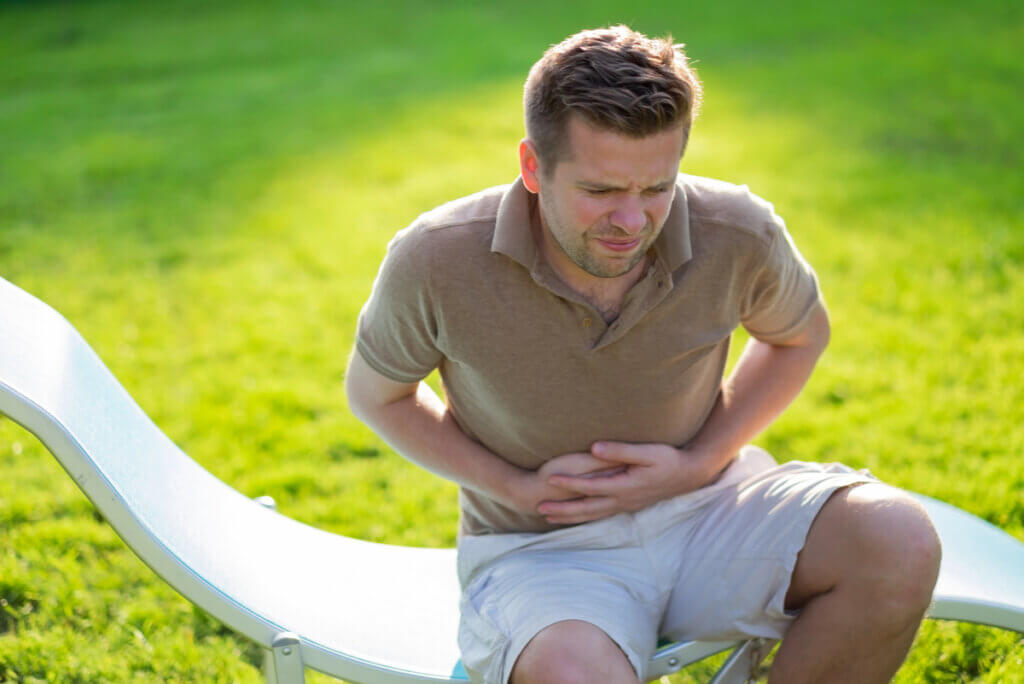The Symptoms and Causes of Gastroenteritis

Different gastrointestinal diseases are common around the world and present with similar symptoms. One of them is gastroenteritis, which can be very dangerous due to the risk of dehydration, especially in young children. Therefore, it’s important to be aware of the symptoms and causes of gastroenteritis.
Gastroenteritis is a disease characterized by inflammation of the mucous layer that lines the stomach and intestines. It’s usually of infectious origin and its main symptom is diarrhea. In most cases, it is a self-limiting condition that subsides after a few days.
According to data from the Spanish Association of Pediatrics, it causes the death of at least 4 million children a year in low-income countries. In developed countries, its mortality is low, however, it continues to be a frequent reason for consultation in the area of pediatrics.
The causes of gastroenteritis
This gastrointestinal disorder can be caused by a large number of infectious agents, such as bacteria, viruses, and parasites. The most frequent causes of gastroenteritis may vary depending on the geographic location of the patient. Viruses are the main origin of the disease.
However, in rural areas and developing countries, the most common causative agents are parasites and bacteria. All these microorganisms enter the body through the mouth through food or colonized objects. Once they reach the intestine, they cause inflammation and consequent symptoms.
Viral gastroenteritis
The most frequently isolated virus in adults belongs to the norovirus family, according to epidemiological studies. It’s the agent in 90% of cases in the United States. In children, it’s more common to find viruses belonging to the rotavirus family.
These particles infect the cells of the mucous membrane of the intestine, causing a profuse leakage of fluid into the intestinal lumen. Bloody diarrhea is a very rare finding in this type of infection.

Bacterial gastroenteritis
Bacteria can use a variety of mechanisms to cause gastroenteritis, from the use of toxins to the invasion and destruction of cells. The most common causative agents that have been identified are Escherichia coli, Salmonella spp., and Campylobacter spp.
Parasitic gastroenteritis
When we think of gastrointestinal diseases, parasites often come to mind. Various species, such as Giardia intestinalis, are capable of adhering to and invading the mucous membrane, causing inflammation. Other frequently isolated parasites are Cryptosporidium spp. and Entamoeba histolytica.
Non-infectious gastroenteritis
At the same time, there are several cases in which the inflammation of the gastric mucosa isn’t related to any biological pathogen. In this regard, an underlying disease may be the cause, such as Crohn’s disease.
What are the symptoms of gastroenteritis?
The symptoms presented by the patient may vary, depending on the origin of the inflammation. However, the clinic will be quite similar. The onset of symptoms is sudden and occurs shortly after being in contact with the causative agent.
The main sign of gastroenteritis is diarrhea, which can be watery or with blood and mucus, depending on the microorganism’s mechanism of action. It’s quite profuse and is usually accompanied by other symptoms, among which the following stand out:
- Nausea and vomiting
- Abdominal pain and stomach pain
- Loss of appetite or anorexia
- Fever with malaise
Complications in children
In adults, gastroenteritis doesn’t usually present serious complications and is resolved without any inconvenience. However, in the case of little ones, extreme care must be taken, as there’s a risk of suffering severe dehydration.
According to data from the World Health Organization (WHO), diarrheal diseases are the second leading cause of death in children under 5 years of age. Let’s remember that 80% of the body is made up of water, so little ones are more prone to losing it through vomiting and diarrhea.
A child with symptoms of dehydration can die if they don’t receive proper medical attention. In this regard, the main symptoms of this complication include the following:
- Altered consciousness or increased irritability
- Tachycardia
- Decreased amount of urine produced
- Hypotension with a lack of energy
How is gastroenteritis diagnosed?
When evaluating a patient with gastroenteritis, a differentiation must be made with other diseases that present similar symptoms, such as appendicitis or cholecystitis. The specialist shouldn’t focus only on the symptoms, but also on the patient’s lifestyle.
In this sense, it’s likely that the professional will ask questions about the food and drinks the patient has eaten in previous days as well as the places they’ve visited. A physical examination will also be done to palpate the abdomen, identifying the specific painful area.
In some cases, it will also be necessary to indicate a stool examination in order to isolate the etiological agent and initiate the corresponding therapy. In addition, blood tests are prescribed with the aim of evaluating electrolyte and antibody levels.
Treatment for gastroenteritis
The treatments to follow for gastroenteritis will vary according to the etiology. In all cases, reducing the effect of the symptoms will be necessary in order to stabilize the patient. Therefore, fluid and electrolyte replacement is vital, especially in children.
When it comes to a viral infection, the treatment will be symptomatic, as the body itself is capable of eliminating the causative agent. In this regard, simply lowering the fever, reducing vomiting, and decreasing pain will be necessary. In some cases, the administration of probiotics may be necessary to restore the bacterial flora.
On the other hand, the body isn’t capable of eliminating bacteria and parasites on its own, so medication intake is required. For this reason, there are antibiotics and antiparasitics, as the case may be.

Prevention of gastroenteritis
As gastroenteritis can be produced by microorganisms that can inhabit food, it’s possible to take certain measures to prevent the appearance of this disease. Washing fruits and vegetables properly and cooking food thoroughly and properly helps to eliminate eliminating most germs.
Hand washing before eating food and after using the bathroom is also recommended, as many of these microorganisms are found in the human gastrointestinal tract. In the case of children, it’s possible to apply vaccines against rotavirus, which grants them immunity for a certain time.
When you’re traveling, you should avoid eating in unhealthy places at all costs. If you travel to a country with problems in the purification of water, you should only drink bottled water. This is because the vital fluid can also harbor viruses, bacteria, and parasites, which, as we’ve already mentioned, are among the most common causes of gastroenteritis.
What to remember about this disease?
Although gastroenteritis isn’t usually lethal in healthy adults, it’s capable of causing great damage in children. Therefore, it’s crucial to see a doctor as soon as the first symptoms of the disease appear. This way, timely treatment can be started and complications can be avoided.
If you have diarrhea or any other symptoms, it’s important to have adequate hygiene regarding your hands and avoid contact with food. All etiological agents can inhabit various surfaces and be ingested by other people, multiplying the contagion.
Different gastrointestinal diseases are common around the world and present with similar symptoms. One of them is gastroenteritis, which can be very dangerous due to the risk of dehydration, especially in young children. Therefore, it’s important to be aware of the symptoms and causes of gastroenteritis.
Gastroenteritis is a disease characterized by inflammation of the mucous layer that lines the stomach and intestines. It’s usually of infectious origin and its main symptom is diarrhea. In most cases, it is a self-limiting condition that subsides after a few days.
According to data from the Spanish Association of Pediatrics, it causes the death of at least 4 million children a year in low-income countries. In developed countries, its mortality is low, however, it continues to be a frequent reason for consultation in the area of pediatrics.
The causes of gastroenteritis
This gastrointestinal disorder can be caused by a large number of infectious agents, such as bacteria, viruses, and parasites. The most frequent causes of gastroenteritis may vary depending on the geographic location of the patient. Viruses are the main origin of the disease.
However, in rural areas and developing countries, the most common causative agents are parasites and bacteria. All these microorganisms enter the body through the mouth through food or colonized objects. Once they reach the intestine, they cause inflammation and consequent symptoms.
Viral gastroenteritis
The most frequently isolated virus in adults belongs to the norovirus family, according to epidemiological studies. It’s the agent in 90% of cases in the United States. In children, it’s more common to find viruses belonging to the rotavirus family.
These particles infect the cells of the mucous membrane of the intestine, causing a profuse leakage of fluid into the intestinal lumen. Bloody diarrhea is a very rare finding in this type of infection.

Bacterial gastroenteritis
Bacteria can use a variety of mechanisms to cause gastroenteritis, from the use of toxins to the invasion and destruction of cells. The most common causative agents that have been identified are Escherichia coli, Salmonella spp., and Campylobacter spp.
Parasitic gastroenteritis
When we think of gastrointestinal diseases, parasites often come to mind. Various species, such as Giardia intestinalis, are capable of adhering to and invading the mucous membrane, causing inflammation. Other frequently isolated parasites are Cryptosporidium spp. and Entamoeba histolytica.
Non-infectious gastroenteritis
At the same time, there are several cases in which the inflammation of the gastric mucosa isn’t related to any biological pathogen. In this regard, an underlying disease may be the cause, such as Crohn’s disease.
What are the symptoms of gastroenteritis?
The symptoms presented by the patient may vary, depending on the origin of the inflammation. However, the clinic will be quite similar. The onset of symptoms is sudden and occurs shortly after being in contact with the causative agent.
The main sign of gastroenteritis is diarrhea, which can be watery or with blood and mucus, depending on the microorganism’s mechanism of action. It’s quite profuse and is usually accompanied by other symptoms, among which the following stand out:
- Nausea and vomiting
- Abdominal pain and stomach pain
- Loss of appetite or anorexia
- Fever with malaise
Complications in children
In adults, gastroenteritis doesn’t usually present serious complications and is resolved without any inconvenience. However, in the case of little ones, extreme care must be taken, as there’s a risk of suffering severe dehydration.
According to data from the World Health Organization (WHO), diarrheal diseases are the second leading cause of death in children under 5 years of age. Let’s remember that 80% of the body is made up of water, so little ones are more prone to losing it through vomiting and diarrhea.
A child with symptoms of dehydration can die if they don’t receive proper medical attention. In this regard, the main symptoms of this complication include the following:
- Altered consciousness or increased irritability
- Tachycardia
- Decreased amount of urine produced
- Hypotension with a lack of energy
How is gastroenteritis diagnosed?
When evaluating a patient with gastroenteritis, a differentiation must be made with other diseases that present similar symptoms, such as appendicitis or cholecystitis. The specialist shouldn’t focus only on the symptoms, but also on the patient’s lifestyle.
In this sense, it’s likely that the professional will ask questions about the food and drinks the patient has eaten in previous days as well as the places they’ve visited. A physical examination will also be done to palpate the abdomen, identifying the specific painful area.
In some cases, it will also be necessary to indicate a stool examination in order to isolate the etiological agent and initiate the corresponding therapy. In addition, blood tests are prescribed with the aim of evaluating electrolyte and antibody levels.
Treatment for gastroenteritis
The treatments to follow for gastroenteritis will vary according to the etiology. In all cases, reducing the effect of the symptoms will be necessary in order to stabilize the patient. Therefore, fluid and electrolyte replacement is vital, especially in children.
When it comes to a viral infection, the treatment will be symptomatic, as the body itself is capable of eliminating the causative agent. In this regard, simply lowering the fever, reducing vomiting, and decreasing pain will be necessary. In some cases, the administration of probiotics may be necessary to restore the bacterial flora.
On the other hand, the body isn’t capable of eliminating bacteria and parasites on its own, so medication intake is required. For this reason, there are antibiotics and antiparasitics, as the case may be.

Prevention of gastroenteritis
As gastroenteritis can be produced by microorganisms that can inhabit food, it’s possible to take certain measures to prevent the appearance of this disease. Washing fruits and vegetables properly and cooking food thoroughly and properly helps to eliminate eliminating most germs.
Hand washing before eating food and after using the bathroom is also recommended, as many of these microorganisms are found in the human gastrointestinal tract. In the case of children, it’s possible to apply vaccines against rotavirus, which grants them immunity for a certain time.
When you’re traveling, you should avoid eating in unhealthy places at all costs. If you travel to a country with problems in the purification of water, you should only drink bottled water. This is because the vital fluid can also harbor viruses, bacteria, and parasites, which, as we’ve already mentioned, are among the most common causes of gastroenteritis.
What to remember about this disease?
Although gastroenteritis isn’t usually lethal in healthy adults, it’s capable of causing great damage in children. Therefore, it’s crucial to see a doctor as soon as the first symptoms of the disease appear. This way, timely treatment can be started and complications can be avoided.
If you have diarrhea or any other symptoms, it’s important to have adequate hygiene regarding your hands and avoid contact with food. All etiological agents can inhabit various surfaces and be ingested by other people, multiplying the contagion.
- Gavilán Martín C, García Avilés B, González Montero R. Gastroenteritis aguda. Protocolos diagnóstico-terapéuticos de la AEP: Infectología pediátrica. Capítulo 13. 113-124. Documento disponible online en: https://www.aeped.es/sites/default/files/documentos/gea.pdf.
- Yalda Lucero A. Etiología y manejo de la gastroenteritis aguda infecciosa en niños y adultos. Revista Médica Clínica Las Condes. 2014;25(3):463-472.
- Glass R, Parashar U, Estes M. Norovirus Gastroenteritis. The New England Journal of Medicine. 2009; 361:1776-1785.
- Gutiérrez Castrellón P, Polanco Allué I, Salazar Lindo E. Manejo de la gastroenteritis aguda en menores de 5 años: un enfoque basado en la evidencia. Anales de Pediatría 2010;72(3): 220-220.
- De Miguel Durán F, Perdomo Giraldi M. Gastroenteritis aguda. Deshidratación. Pediatría Integral. 2011;15(1):54-60.
- Boyce T. Gastroenteritis – Trastornos gastrointestinales [Internet]. Manual MSD versión para profesionales. 2019. Available from: https://www.msdmanuals.com/es/professional/trastornos-gastrointestinales/gastroenteritis/gastroenteritis.
- Vera, César García, et al. “Gastroenteritis aguda bacteriana: 729 casos reclutados por una red nacional de atención primaria.” Anales de Pediatría. Vol. 87. No. 3. Elsevier Doyma, 2017.
- Amin Blanco, Nevis, and Sonsire Fernández Castillo. “Vacunas contra rotavirus: estado actual y tendencias futuras.” Vaccimonitor 25.3 (2016): 0-0.
Este texto se ofrece únicamente con propósitos informativos y no reemplaza la consulta con un profesional. Ante dudas, consulta a tu especialista.







